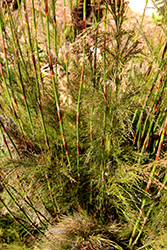It's all about ...
plants

Height: 15 feet
Spread: 3 feet
Sunlight:
![]()
![]()
Hardiness Zone: 8b
Other Names: Mexican Giant Horsetail
Description:
This is a prehistoric remnant, and is the tallest of living horsetails; clumps of towering spikes with narrow branchlets at the nodes creates a bold vertical effect that makes an excellent backdrop in a high groundwater area; very low maintenance
Ornamental Features
Giant Horsetail is primarily valued in the landscape for its pronouncedly upright and towering form. Its attractive tiny threadlike leaves remain green in colour throughout the season. The green stems are very colorful and add to the overall interest of the plant.
Landscape Attributes
Giant Horsetail is a dense herbaceous perennial with a rigidly upright and towering form. Its relatively fine texture sets it apart from other garden plants with less refined foliage.
This is a relatively low maintenance plant, and is best cleaned up in early spring before it resumes active growth for the season. Deer don't particularly care for this plant and will usually leave it alone in favor of tastier treats. Gardeners should be aware of the following characteristic(s) that may warrant special consideration;
- Spreading
Giant Horsetail is recommended for the following landscape applications;
- Accent
- Mass Planting
- Hedges/Screening
- Bog Gardens
Planting & Growing
Giant Horsetail will grow to be about 15 feet tall at maturity, with a spread of 3 feet. It grows at a fast rate, and under ideal conditions can be expected to live for approximately 10 years. As an herbaceous perennial, this plant will usually die back to the crown each winter, and will regrow from the base each spring. Be careful not to disturb the crown in late winter when it may not be readily seen!
This plant does best in full sun to partial shade. It prefers to grow in moist to wet soil, and will even tolerate some standing water. This plant does not require much in the way of fertilizing once established. It is not particular as to soil pH, but grows best in rich soils. It is somewhat tolerant of urban pollution. This species is not originally from North America. It can be propagated by division.
This plant is not reliably hardy in our region, and certain restrictions may apply; contact the store for more information.
